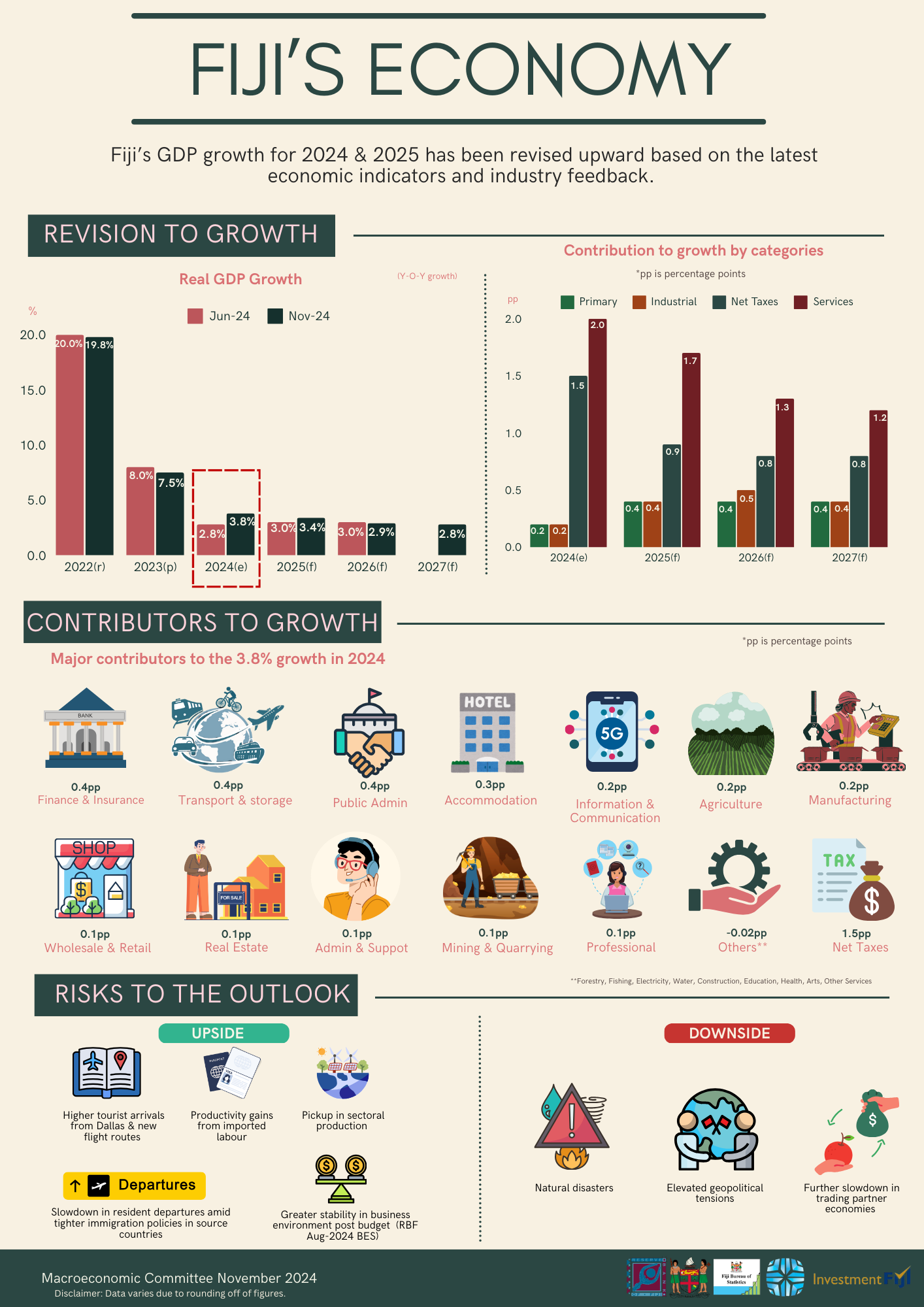Press Release No. 27/2024
Date: 15 November 2024
STATEMENT BY THE CHAIRMAN OF THE MACROECONOMIC COMMITTEE[1] AND GOVERNOR OF THE RESERVE BANK OF FIJI
REVISIONS TO THE MACROECONOMIC PROJECTIONS FOR THE FIJIAN ECONOMY (2024-2027)
The Macroeconomic Committee announced today the updated GDP growth forecasts for Fiji.
The Fiji economy is now forecast to grow by 3.8 percent in 2024, an upward revision from the 2.8 percent projected in June this year. The upgrade in economic growth reflects notable improvements in several partial indicators from the middle of the year. Underpinning the higher growth is the better-than-expected outturn in visitor arrivals, which grew by 6.3 percent in the year to September, almost twice the projected increase in arrivals. Consumption spending has gathered pace, supported by higher incomes and remittances, tourism-driven demand, higher Government spending and the pickup in new lending. Investment activity continues to progress but at a slower than desired pace. While labour shortages and ease of doing business processes are gradually improving, investors still face a relatively higher-cost environment, impacting both the completion of existing and commencement of new projects.
Similarly, growth for 2025 has now been upgraded to 3.4 percent from the 3.0 percent expected earlier. The service and-related sectors remain the main contributors to growth, followed by industrial and primary sectors. In 2026 and 2027, economic growth is forecast to be 2.9 percent and 2.8 percent, respectively, with the economy reverting to its long-term growth rates.
The Committee also notes that based on the GDP report by the Fiji Bureau of Statistics (FBOS), there was a slight downward revision to 2022 GDP (from 20.0% to 19.8%), as well as the 2023 GDP coming in lower than estimated (from 8.0% to 7.5%). At the same time, the FBOS report also indicates that outcomes in thirteen sectors[2] are still below pre-pandemic levels as of 2023, which the Committee projects to note a gradual return over the near term. On the positive side, eight sectors[3] and the overall economy has already surpassed pre-pandemic levels in 2023.
Risks to the outlook are balanced. While natural disasters, elevated geopolitical tensions and further slowdown in trading partner economies pose downside risks; higher tourist arrivals from Dallas and new flight routes, pickup in sectoral production and greater stability in the business environment post-budget, as highlighted in the August 2024 Business Expectations Survey, could weigh positively on growth. Complementing the outcome are the expected slowdown in resident departures amid tighter immigration policies in source countries and productivity gains from imported labour.
The Chair concluded, “although there are symptoms of improvement, we must remain agile to create an economic terrain to foster sustainable economic growth.”
The Macroeconomic Committee will review these projections in the second quarter of 2025.
ARIFF ALI
Chairman of the Macroeconomic Committee
[1] The Macroeconomic Committee is made up of heads and senior representatives from the Ministry of Finance; Fiji Bureau of Statistics; Ministry of Trade, Co-operatives and Small and Medium Enterprises, Ministry of Tourism and Civil Aviation, Office of the Prime Minister; Investment Fiji; Fiji Revenue & Customs Service and the Reserve Bank of Fiji.
[2] These are: Fishing & Aquaculture, Mining & Quarrying, Manufacturing, Water, Construction, Wholesale & Retail Trade, Accommodation, Real Estate, Professional Services, Administrative Services, Public Administration, Arts & Entertainment and Other Services.
[3] These are: Agriculture, Forestry & Logging, Electricity, Transport & Storage, Information & Communication, Financial & Insurance, Education and Health.


